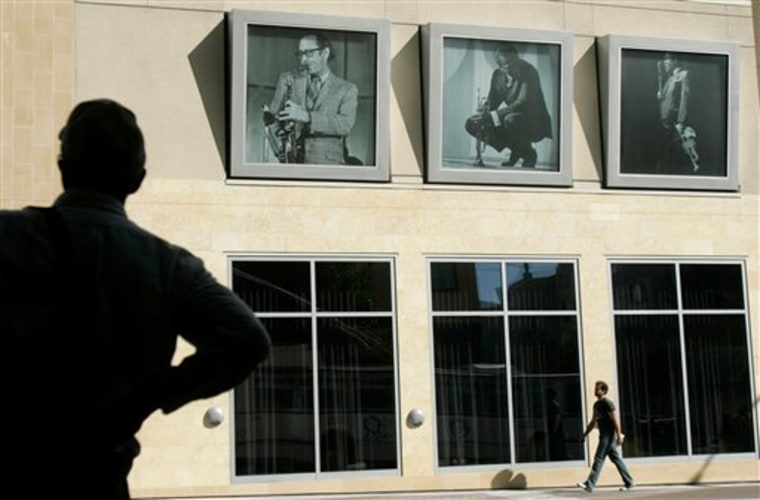Holding her cane and shuffling carefully down the sidewalk in the city's Jazz Preservation District, 88-year-old Leola King stopped and looked at the words stamped in concrete: Leola King's Birdcage, 1505 Fillmore.
Today, the site of King's 1960s nightclub is a Starbucks on the ground floor of a condominium tower.
A half-century ago, this neighborhood was nicknamed "Harlem of the West" and hundreds of black-owned businesses thrived here. At night its gritty streets were filled with the sounds of jazz and blues drifting from nightclubs.
Then the government, using race as a factor in its decision, decreed the area blighted and forced thousands of people, including King, from the neighborhood by way of eminent domain. The din of bulldozers and wrecking balls replaced the saxophones and snare drum-raps with the promise of a better neighborhood.
Many critical of urban renewal efforts
It was a scenario that played out across the nation in black communities in Chicago, Atlanta, New York, Boston, Kansas City, Mo., and others, as the federal and local governments undertook urban renewal projects that reshaped and, some say, ruined redevelopment areas like the Western Addition, where the Fillmore District is located.
Its work done, the San Francisco Redevelopment Agency — the state-and-federally funded agency that managed the project — will without fanfare end one of the nation's longest-running urban renewal projects on Jan. 1.
"Thousands of units of affordable housing have been developed, and there has been lots of investment and economic development but none of that has been able to make up for the tremendous sense of loss the people who lived in the Western Addition feel in terms of the cultural fabric," said Fred Blackwell, the agency's executive director.
In all, 90 city blocks were torn down and rebuilt. Most of what remains of the area's celebrated past are old photographs, fading memories and new jazz venues that echo the area's rich musical heritage.
For King, there's no reason to celebrate the end of redevelopment. She lost almost everything.
"In her day, she was one of the wealthiest women in San Francisco and that's no joke," said San Francisco Supervisor Ross Mirkarimi, whose district includes Western Addition. "They took a self-made woman and basically subverted her stature."
Battle ended in bankruptcy
Documents show that King lost businesses — two nightclubs and a barbecue restaurant — and numerous residential properties. She spent decades in a losing battle with the agency that ended in bankruptcy after she defaulted on real estate loans.
She now lives in a garage that was converted into an apartment, surrounded by gilded mirrors and chandeliers that once decorated her clubs.
Redevelopment displaced almost 900 businesses in the Western Addition and more than 4,700 homes, including blocks of grand, historic Victorians. Agency records do not show how many residents ever returned.
Population was growing rapidly
The city's black population was growing rapidly when redevelopment began in the 1950s. By the mid-1970s, however, blocks sat vacant and the black population had started its decades-long slide from about 13 percent to half that in 2005 — the biggest percentage decline of any major city.
On the block where King's Birdcage used to be, the New Chicago Barbershop is the only black-owned business that returned after development. "Basically, everything's been lost," said barber Reggis Pettus, standing beneath photos from the neighborhood's heyday. "They put up a big old high-rise that two-thirds of the people who lived here can't afford."
King lost her first business to urban renewal — a barbecue restaurant called Oklahoma King's — in 1958. She speaks about it today as if she can still hear the crowds pouring in from jazz clubs and see a line out the door after midnight.
She was forced to sell Oklahoma King's for less than she paid for the land. She received nothing for the buildings there or her restaurant equipment.
Next she remodeled a neighborhood nightclub, which she named the Blue Mirror and built into a premier nightclub. Oftentimes, black touring acts — John Coltrane, Etta James, T-Bone Walker — would play to white audiences downtown in the early evening, then come to the Fillmore.
Forced to move again
In 1962, the redevelopment agency targeted the Blue Mirror's location and King was forced to move again.
Two years later, she opened the Birdcage and added an apartment building and other real estate to her growing empire.
King said an official told her the new nightclub was outside their target area for the wrecker's ball, but she was evicted by court order in 1974 and the building was demolished. For more than two decades, King fought the redevelopment agency over millions of dollars she wanted to reestablish the Birdcage at another location.
Today, her Birdcage and Blue Mirror are now immortalized on a "jazz walk of fame" in the preservation district established in 2003.
"When I walk through the neighborhood now, ... I mourn for what has been lost," said Elizabeth Pepin, co-author of "Harlem of the West." "The neighborhood undoubtedly would have changed, as all neighborhoods do. But it would have been organically brought about by the people who lived in the neighborhood."
Today, city voters are being asked to approve an $8 billion redevelopment of one of the city's remaining black neighborhoods, the Bayview-Hunter's Point.
Blackwell said the mistakes made in the Fillmore and Western Addition will not be repeated because lessons have been learned and the law has been changed to protect the inhabitants of redevelopment areas.
"We're not trying to replicate what happened (there)," he said.
